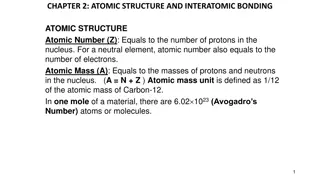Chemistry Review Exercise: Periodic Table and Atomic Properties Review
This detailed content covers a review exercise on the Periodic Table and Atomic Properties of various elements. It includes information on atomic structures, fundamental physical constants, and common elements found in the Periodic Table. The content explores elements from Hydrogen to Osmium, detailing their atomic numbers, configurations, and properties. Additionally, it touches on topics like the speed of light, electron mass, and important constants in physics. Perfect for a comprehensive revision of chemistry concepts related to the Periodic Table.
Download Presentation

Please find below an Image/Link to download the presentation.
The content on the website is provided AS IS for your information and personal use only. It may not be sold, licensed, or shared on other websites without obtaining consent from the author.If you encounter any issues during the download, it is possible that the publisher has removed the file from their server.
You are allowed to download the files provided on this website for personal or commercial use, subject to the condition that they are used lawfully. All files are the property of their respective owners.
The content on the website is provided AS IS for your information and personal use only. It may not be sold, licensed, or shared on other websites without obtaining consent from the author.
E N D
Presentation Transcript
Chemistry Review Exercise SOIL 4234 Laboratory No. 1
P E R I O D I C T A B L E Group 1 IA Atomic Properties of the Elements 18 VIIIA Physics Laboratory physics.nist.gov Standard Reference Data Group www.nist.gov/srd 1 2He Helium 4.002602 1s2 2S1/2 1S0 Frequently used fundamental physical constants For the most accurate values of these and other constants, visit physics.nist.gov/constants H 1 1 second = 9 192 631 770 periods of radiation corresponding to the transition between the two hyperfine levels of the ground state of Hydrogen 1.00794 1s 133Cs (exact) ( 2 13 IIIA 14 IVA 15 VA 16 VIA 17 VIIA 299 792 458 m s-1 6.6261 10-34 J s 1.6022 10-19 C 9.1094 10-31 kg Solids Liquids Gases speed of light in vacuum Planck constant elementary charge electron mass c h e me mec2 mp IIA /2 ) 13.5984 24.5874 5 6 7 8 9 10 3 4Be Beryllium 9.012182 1s22s2 2P1/2 3P0 2P3/2 4S3/2 3P2 1S0 1S0 2S1/2 Li Lithium 6.941 B Boron 10.811 1s22s22p C Carbon 12.0107 1s22s22p2 N Nitrogen 14.0067 1s22s22p3 O Oxygen 15.9994 1s22s22p4 F Ne Neon 20.1797 1s22s22p6 Artificially Prepared 0.5110 MeV 1.6726 10-27 kg 2 Fluorine 18.9984032 1s22s22p5 proton mass fine-structure constant Rydberg constant 1/137.036 10 973 732 m-1 3.289 842 1015 Hz 1s22s 5.3917 R R c R hc 9.3227 8.2980 11.2603 14.5341 13.6181 17.4228 21.5645 11Na Sodium 22.989770 [Ne]3s 12 13Al Aluminum 26.981538 [Ne]3s23p 14Si Silicon 28.0855 [Ne]3s23p2 15P Phosphorus 30.973761 [Ne]3s23p3 16S Sulfur 32.065 [Ne]3s23p4 17Cl Chlorine 35.453 [Ne]3s23p5 18Ar Argon 39.948 [Ne]3s23p6 1S0 2P1/2 2S1/2 3P0 2P3/2 4S3/2 3P2 1S0 13.6057 eV Mg Magnesium 24.3050 [Ne]3s2 1.3807 10-23 J K -1 Boltzmann constant k 3 3 4 5 6 7 8 9 10 11 IB 12 IIB IIIB IVB VB VIB VIIB VIII 5.1391 7.6462 5.9858 8.1517 10.4867 33As Arsenic 74.92160 [Ar]3d104s24p3 10.3600 34Se Selenium 78.96 [Ar]3d104s24p4 12.9676 35Br Bromine 79.904 [Ar]3d104s24p5 15.7596 36Kr Krypton 83.798 [Ar]3d104s24p6 19K Potassium 39.0983 [Ar]4s 20Ca Calcium 40.078 [Ar]4s2 21Sc Scandium 44.955910 [Ar]3d4s2 22Ti Titanium 47.867 [Ar]3d24s2 23V Vanadium 50.9415 [Ar]3d34s2 24Cr Chromium 51.9961 [Ar]3d54s 25 26Fe 27 28Ni Nickel 58.6934 [Ar]3d84s2 29 30Zn Zinc 65.409 [Ar]3d104s2 31 32 1S0 2P1/2 1S0 2D3/2 3F4 2S1/2 4F3/2 7S3 6S5/2 5D4 2S1/2 3P0 2P3/2 4F9/2 4S3/2 3P2 1S0 3F2 Mn Manganese 54.938049 [Ar]3d54s2 Co Cobalt 58.933200 [Ar]3d74s2 Cu Copper 63.546 [Ar]3d104s Ga Gallium 69.723 [Ar]3d104s24p Ge Germanium 72.64 [Ar]3d104s24p2 Period 4 Iron 55.845 [Ar]3d64s2 4.3407 6.1132 6.5615 6.8281 6.7462 6.7665 7.4340 7.9024 7.8810 7.6398 7.7264 9.3942 5.9993 7.8994 9.7886 9.7524 11.8138 13.9996 37 38Sr Strontium 87.62 [Kr]5s2 39Y Yttrium 88.90585 [Kr]4d5s2 40Zr Zirconium 91.224 [Kr]4d25s2 41 42 43Tc Technetium (98) [Kr]4d55s2 44 45 46Pd Palladium 106.42 [Kr]4d10 47 48 49In Indium 114.818 [Kr]4d105s25p 50Sn 51Sb Antimony 121.760 [Kr]4d105s25p3 52Te Tellurium 127.60 [Kr]4d105s25p4 53I Iodine 126.90447 [Kr]4d105s25p5 54Xe Xenon 131.293 [Kr]4d105s25p6 6S5/2 4F9/2 1S0 6D1/2 7S3 2D3/2 2P1/2 2S1/2 1S0 5F5 1S0 2S1/2 3F2 3P0 2P3/2 4S3/2 3P2 1S0 Rb Rubidium 85.4678 [Kr]5s Nb Niobium 92.90638 [Kr]4d45s Mo Molybdenum 95.94 [Kr]4d55s Ru Ruthenium 101.07 [Kr]4d75s Rh Rhodium 102.90550 [Kr]4d85s Ag Silver 107.8682 [Kr]4d105s Cd Cadmium 112.411 [Kr]4d105s2 5 Tin 118.710 [Kr]4d105s25p2 4.1771 5.6949 6.2173 6.6339 6.7589 7.0924 7.28 7.3605 7.4589 8.3369 7.5762 8.9938 5.7864 7.3439 8.6084 9.0096 10.4513 85At Astatine (210) [Hg]6p5 12.1298 55Cs Cesium 132.90545 [Xe]6s 56Ba Barium 137.327 [Xe]6s2 72Hf Hafnium 178.49 [Xe]4f145d26s2 73Ta Tantalum 180.9479 [Xe]4f145d36s2 74W Tungsten 183.84 [Xe]4f145d46s2 75Re Rhenium 186.207 [Xe]4f145d56s2 76 77Ir Iridium 192.217 [Xe]4f145d76s2 78Pt Platinum 195.078 [Xe]4f145d96s 79 80 81Tl Thallium 204.3833 [Hg]6p 82Pb Lead 207.2 [Hg]6p2 83Bi Bismuth 208.98038 [Hg]6p3 84Po Polonium (209) [Hg]6p4 86 1S0 1S0 2S1/2 3D3 2P1/2 4F3/2 5D0 6S5/2 5D4 2S1/2 4F9/2 3P0 2P3/2 3F2 4S3/2 3P2 1S0 Os Osmium 190.23 [Xe]4f145d66s2 Au Gold 196.96655 [Xe]4f145d106s Hg Mercury 200.59 [Xe]4f145d106s2 Rn Radon (222) [Hg]6p6 6 3.8939 5.2117 6.8251 7.5496 7.8640 7.8335 8.4382 8.9670 8.9588 9.2255 10.4375 112 Uub Ununbium (285) 6.1082 7.4167 7.2855 8.414 10.7485 87Fr Francium (223) [Rn]7s 88Ra Radium (226) [Rn]7s2 104 105 106 107 108 109 110 Uun Ununnilium (281) 111 Uuu Unununium (272) 114 Uuq Ununquadium (289) 116 Uuh Ununhexium (292) 3F2 1S0 2S1/2 ? Rf Db Dubnium (262) Sg Seaborgium (266) Bh Bohrium (264) Hs Hassium (277) Mt Meitnerium (268) 7 Rutherfordium (261) [Rn]5f146d27s2? 4.0727 5.2784 6.0 ? Atomic Number Ground-state Level 57La Lanthanum 138.9055 [Xe]5d6s2 58Ce Cerium 140.116 [Xe]4f5d6s2 59Pr Praseodymium 140.90765 [Xe]4f36s2 60 61 62 63Eu Europium 151.964 [Xe]4f76s2 64 65Tb Terbium 158.92534 [Xe]4f96s2 66Dy Dysprosium 162.500 [Xe]4f106s2 67 68Er Erbium 167.259 [Xe]4f126s2 69 70Yb Ytterbium 173.04 [Xe]4f146s2 71Lu Lutetium 174.967 [Xe]4f145d6s2 5I8 2D3/2 1G4 4I9/2 5I4 6H5/2 7F0 8S7/2 9D2 6H15/2 4I15/2 3H6 2F7/2 1S0 2D3/2 Lanthanides Nd Neodymium 144.24 [Xe]4f46s2 Pm Promethium (145) [Xe]4f56s2 Sm Samarium 150.36 [Xe]4f66s2 Gd Gadolinium 157.25 [Xe]4f75d6s2 Ho Holmium 164.93032 [Xe]4f116s2 Tm Thulium 168.93421 [Xe]4f136s2 58 1G4 Symbol Ce Cerium 140.116 [Xe]4f5d6s2 Name 5.5769 5.5387 5.473 5.5250 5.582 5.6437 5.6704 6.1498 5.8638 5.9389 6.0215 6.1077 6.1843 6.2542 5.4259 89Ac Actinium (227) [Rn]6d7s2 90Th Thorium 232.0381 [Rn]6d27s2 91Pa Protactinium 231.03588 [Rn]5f26d7s2 92U Uranium 238.02891 [Rn]5f36d7s2 93 94Pu Plutonium (244) [Rn]5f67s2 95 Am Americium (243) [Rn]5f77s2 96 Cm Curium (247) [Rn]5f76d7s2 97Bk Berkelium (247) [Rn]5f97s2 98Cf Californium (251) [Rn]5f107s2 99Es Einsteinium (252) [Rn]5f117s2 100 Fm Fermium (257) [Rn]5f127s2 101 Md Mendelevium (258) [Rn]5f137s2 102 103 4I15/2 2D3/2 4K11/2 5I8 3H6 2F7/2 2P1/2 3F2 6L11/2 7F0 8S7/2 6H15/2 1S0 5L6 9D2 ? Atomic Weight Np Neptunium (237) [Rn]5f46d7s2 No Nobelium (259) [Rn]5f147s2 Lr Lawrencium (262) [Rn]5f147s27p? Actinides 5.5387 Ground-state Configuration Ionization Energy (eV) 5.17 6.3067 5.89 6.1941 6.2657 6.0260 5.9738 5.9914 6.1979 6.2817 6.42 6.50 6.58 6.65 4.9 ? Based upon 12C. () indicates the mass number of the most stable isotope. For a description of the data, visit physics.nist.gov/data NIST SP 966 (September 2003)
Binary compounds The cation is always named first and the anion second A simple cation (obtained from a single atom) takes its name from the name of the element A simple anion is named by taking the first part of the element name (the root) and adding ide. Example: NaCl sodium chloride KBr potassium bromide CaO calcium oxide
Ternary compounds Suffixes ite and ate ite element not in its highest valence ate element in its highest valence Example: sulfite, sulfate
Nomenclature of Compounds For cations having two valence states, the higher valence is ic and the lower valence is ous Example: Cu2O: copper (I) oxide - cuprous oxide CuO: copper (II) oxide cupric oxide
Chemical formula Xa+ + Yb- XbYa Na1+ + Cl1- Na1Cl1 NaCl Al3+ + Cl1- AlCl3 Al3+ + SO42- Al2(SO4)3
Molecular weight MgCl Fe203 Na2SO4 Mg = 24.3 g Cl = 35.5 g 59.8 g Fe = 55.8 (2) = 111.6 g O = 16.0 (3) = 48.0 g Na = 23.0 (2) = 46.0 g S = 32.1 = 32.1 g O = 16.0 (4) = 64.0 g 159.6 g 142.1 g
Equivalent weight Equivalent weight = molecular weight valence Equivalent acid or base: Amount of that acid or base that can furnish 1 mole or H+ or OH- ions. CaCO3 CO32- can furnish 2 H+ have a valence of 2 Valences of some elements and compounds are found in pages 4 and 5 of the Chemistry review handouts
Percent material Percent material = element molecular weight total cmpd molecular weight X 100 Percent H in H2SO4 H = 1(2) = 2 S = 32(1) = 32 O = 16 (4) = 64 (2/98)*100 = 2% 98
Number of ions in an acre (3) (Weight/acre) x (1mol element/molecular weight of element) x (# mol H+/# mol N) x (Avogadro s constant) Mole ratio of N and H in NH3 NOTE: Convert weight to appropriate unit Avogadro s constant = 6.02 x 1023 number of units in one mole of any substance (defined as its molecular weight in grams). The units may be electrons, atoms, ions, or molecules, depending on the nature of the substance and the character of the reaction (if any).
pH average pH = -log 10-pH Step1: H+ = -log 10-pH Step 2: Average = total/no. of items Step 3: pH = log average
No. 6 Step 1. Convert mol P to lb P g soil lb soil 1.a. First convert the mol P to lb P 1.b. Then convert g soil to lb soil 1 mol = 1,000,000 mol Step 2. Do ratio and proportion 1 acre has 2,000,000 lbs soil
Titration Step 1. Determine the no. of moles of titrant Step 2. Determine the ratio of titrant and titrand Step 3. Determine the no. of moles of titrand Step 4. Determine the molarity of titrand Titrant is sulfuric acid Titrand is sodium hydroxide
No. of grams compound (8) ppm = mg/L = 10-3g/L gram x mole element x mole cmpd L gram element mole element mol cmpd x g cmpd
Calculating no. of g for a solution (9) M = mol/L mol x mole cmpd L mole element mol cmpd x g cmpd How many moles element in a given compound?
Oxidation state RULES 1. The oxidation state of an element by itself is 0 2. Hydrogen is always 1+ 3. Oxygen is always 2-























